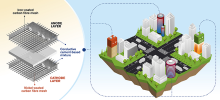
The researchers at Chalmers University in Gothenburg say their invention opens up the tantalising possibility that concrete buildings and structures could one day be used to store large amounts of renewable energy.
“Our research is at an early stage,” says Dr Emma Zhang of Chalmers University. “But we can already see how a building with this technology could charge up with enough electricity from, for example, solar panels during the day, to power it during the night.”
Previous attempts to make a cement battery have used simple metal plates and generated only insignificant current. “They were also unrechargeable,” says Zhang. “We felt we could do much better.”
Working with project supervisor Professor Luping Tang, Zhang developed a fine carbon-fibre mesh coated with iron for the anode, and nickel for the cathode, which was then embedded in a cement mix containing short chopped carbon fibres.
“The fibres increase the conductivity of the cement so it can work as an electrolyte,” says Zhang. “They are about 3mm long, and make up 0.5% of the mix, which would result in a strong product if used in concrete.”
More fibres would increase the battery’s efficiency, she adds, but might affect the workability of the concrete, so future research would focus on achieving an optimal balance.
The mesh too can be modified, says Zhang: “Our experiment used a 5mm square mesh, but this could be varied to permit concrete aggregate to fit through the holes. It might also be possible to use the mesh as a type of reinforcement.”
Zhang’s battery has achieved a capacity of 7Wh/m2. “It doesn’t sound a lot, but used in large structures it begins to add up. If we could improve capacity by five or ten times, which I hope we can with further development, then it starts to become a really useful energy store. Of course, concrete is already used to store energy in the form of heat. Our battery technology would enable concrete to store electrical energy as well. It could provide a useful power source for offshore structures, for example, or buildings in remote areas that do not have access to the grid.”
The researchers say that concrete batteries could help with the problem of intermittency – the uneven supply of renewable energy that results from natural variations in sunshine and wind speed. “So when renewables are not generating much electricity, power supplies could be boosted by energy stored in the fabric of buildings.” Zhang came to research the possibilities of a cement-based battery after leading studies into the electrochemistry of cathodic protection for metals including concrete reinforcement. “I also have a background in polymers, so this research, which is undertaken within the Department of Architecture and Engineering, is a result of several different areas of study coming together to create something with exciting new potential.”
She now hopes to experiment with different meshes and mixes to develop the workability and capacity of the cement batteries: “How long the battery remains rechargeable is also important. Concrete buildings can easily last 50 years and more, so ideally we would want our technology to match that kind of longevity.”







